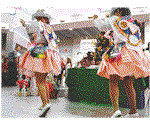

![]()
This
type of melody is known as "Muliza". Its origin goes back to
the first years of the Republican time. Its name comes from the word "Mulero"
and it is part of the rich historical background of Cerro de Pasco. It is part of
the history of its rich minerals such as gold and silver, which were transported by Mules.
The "Argentinean gauchos" from the northern part of Argentina brought to this
region a cadenced tune that was used in their trips while riding th s. Years
later, thes riding workers were known as "Muleros" and lived among in this
area. This cadenced music was transformed to be incorporated in their characteristic
lifestyle. Later on, "La Muliza" was exported to other Peruvian regions.
![]()
![]()
![]()
![]()
![]()
![]()
![]()
I am
from the highest city of this world where people say that they are closer to God, Villa de
Pasco (Cerro de Pasco), a mining city long before the Pre-Incas time. I left my city 6
years ago. I now live in Cantabria - Santander - Spain. While visiting Sevilla I took the
opportunity to review some old manuscripts from the Colonial time in EL ARCHIVO GENERAL DE
INDIAS DE SEVILLA. I remember seeing the route followed by the "Muleros" that
were also used during the times of liberation and independence from Spain.
I am 100% sure that the Argentinean that came from the north of Argentina to work in the mining operation of that region, not only were good mule riders, but were good musicians that utilized the "vihuela" (certain form of guitar), and with their poncho and scarf, used to sing melodious canticles. Those songs later on were incorporated in the popular language as "Muliza" and the peculiar "Huayno Cerreņo" (Mountain Wayno).
It is
really common to observe the presence of the Muliza in the "carnavales". In this
yearly type of events, the competing groups wear their best costumes and sing their best
repertoire. A well known characteristic part of the event is the "Calistrada".
It is a parade in which hundreds of horse riders march through the streets, singing their
Muliza songs with their guitars, violins, mandolins, charangos (small 10 stringed
instruments, looks like the ukulele), clarinets, etc. The Calistrada gave an indescribable
view of this event. The horse riders used to wear their hats, ponchos made of vicuņa
wool. Those were the opulent times of Cerro de Pasco.
I always
used to hear my grandparents talk about of the good old times, in which their ancestors
were the "arrieros" (mule riding workers in the mines of the region). They also
used to mentioned to "La Muliza" and the "Huaynos Cerreņos" as the
types of melodies that originated as a result of the friendship between the local and the
Argentineans that came to this area to work in the mines.
![]() Special
collaboration of Jhanet M. (Peruvian living in Spain)
Special
collaboration of Jhanet M. (Peruvian living in Spain)
![]()